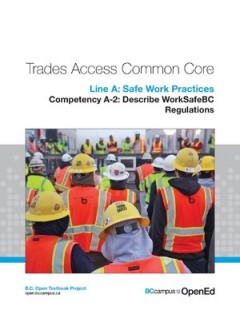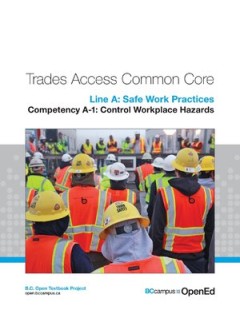Filter by

Line A: Safe Work Practices, Competency A-3, Handle Hazardous Materials Safety
Workers exposed to hazardous materials may be at risk for many serious health problems, such as kidney or lung damage, sterility, cancer, allergic reactions or burns. Some hazardous materials can also cause fires or explosions. Legislation and regulations are in place to reduce injuries or diseases caused by exposure to hazardous materials used in the workplace. Every person working with or nea…
- Edition
- -
- ISBN/ISSN
- -
- Collation
- -
- Series Title
- -
- Call Number
- 331.25 COL l

Line A: Safe Work Practices, Competency A-2, Describe WorkSafeBC Regulations
In most provinces, one or more agencies are responsible for safe, healthful working environments at job sites. These organizations normally have names such as the Workers’ Compensation Board (W.C.B.) or the Occupational Health and Safety Department. WorkSafeBC is the provincial organization that promotes workplace health and safety for workers and employers in B.C. When a work-related injury,…
- Edition
- -
- ISBN/ISSN
- -
- Collation
- -
- Series Title
- -
- Call Number
- 331.25 COL l

Line A: Safe Work Practices, Competency A-1, Control Workplace Hazards
Safety is a part of the job. When you take a job, you have a safety obligation to your employer, co-workers, family and yourself. By recognizing and understanding the hazards in your work area, you can prevent the occurrence of many accidents. Most accidents are preventable. Both employees and employers must take responsibility for making the workplace safe. The following list of lines and comp…
- Edition
- -
- ISBN/ISSN
- -
- Collation
- -
- Series Title
- -
- Call Number
- 331.25 COL l

Line D - Organizational Skills Competency D-5: Use Manufacturer and Supplier …
Document use is one of the nine essential skills identified by the Government of Canada to be successful in the workplace. It refers to the skills needed to find, enter, and use letters, numbers, symbols, and images in electronic and paper form. In the trades, people use document literacy skills to find and enter information in forms, lists, tables, graphs, maps, and drawings. The following lis…
- Edition
- -
- ISBN/ISSN
- -
- Collation
- -
- Series Title
- -
- Call Number
- 330 COL l
 Computer Science, Information & General Works
Computer Science, Information & General Works  Philosophy & Psychology
Philosophy & Psychology  Religion
Religion  Social Sciences
Social Sciences  Language
Language  Pure Science
Pure Science  Applied Sciences
Applied Sciences  Art & Recreation
Art & Recreation  Literature
Literature  History & Geography
History & Geography